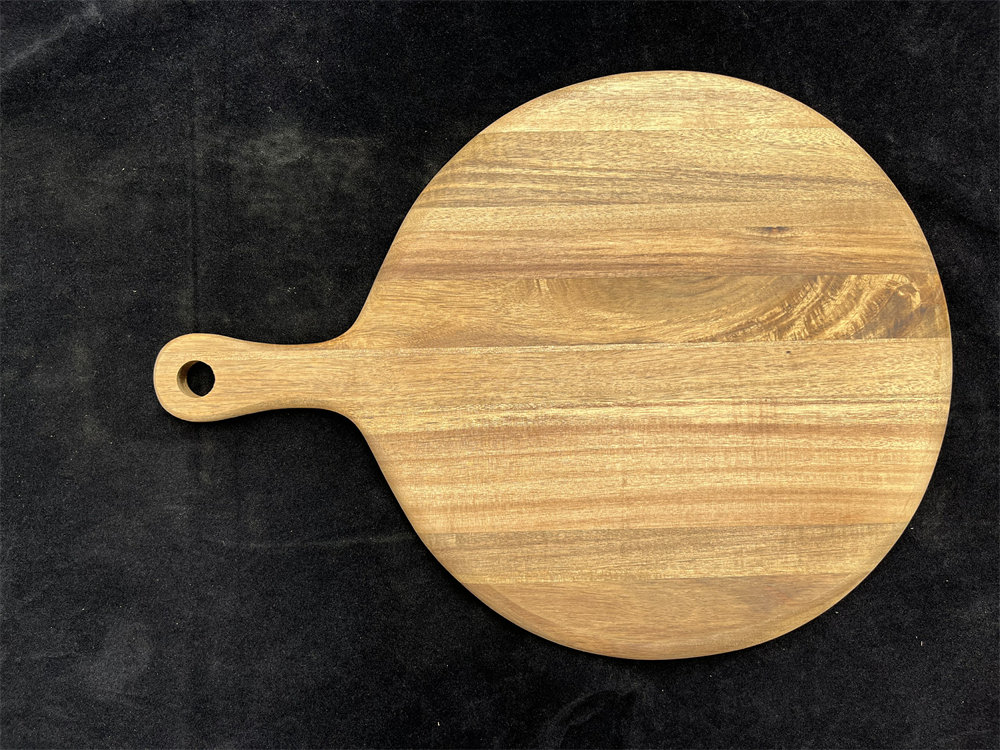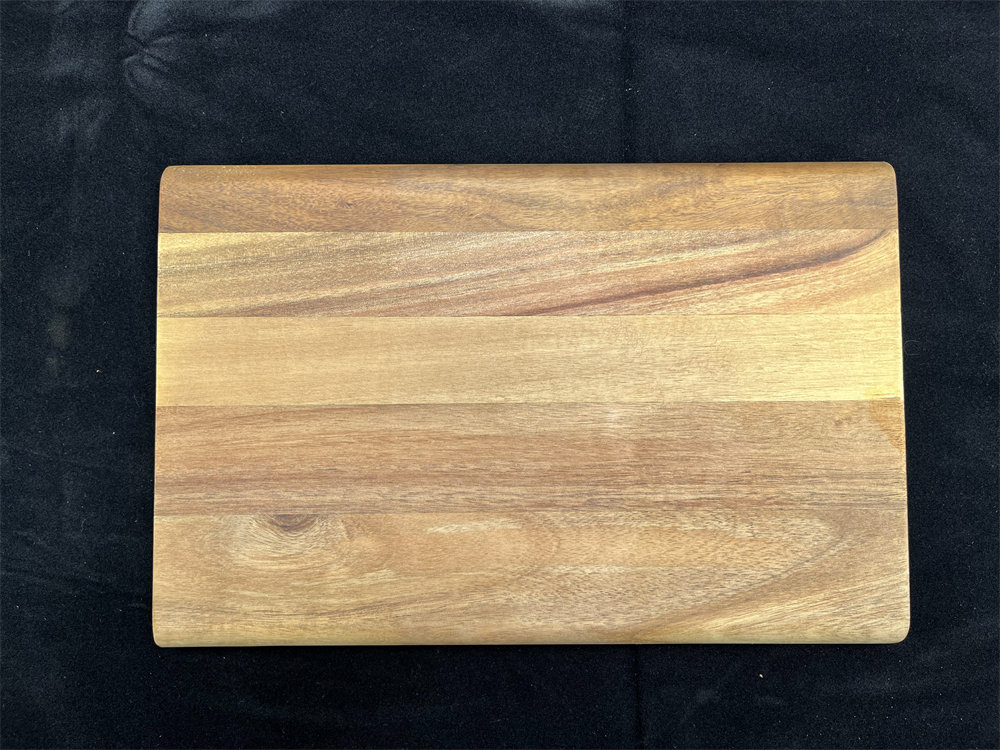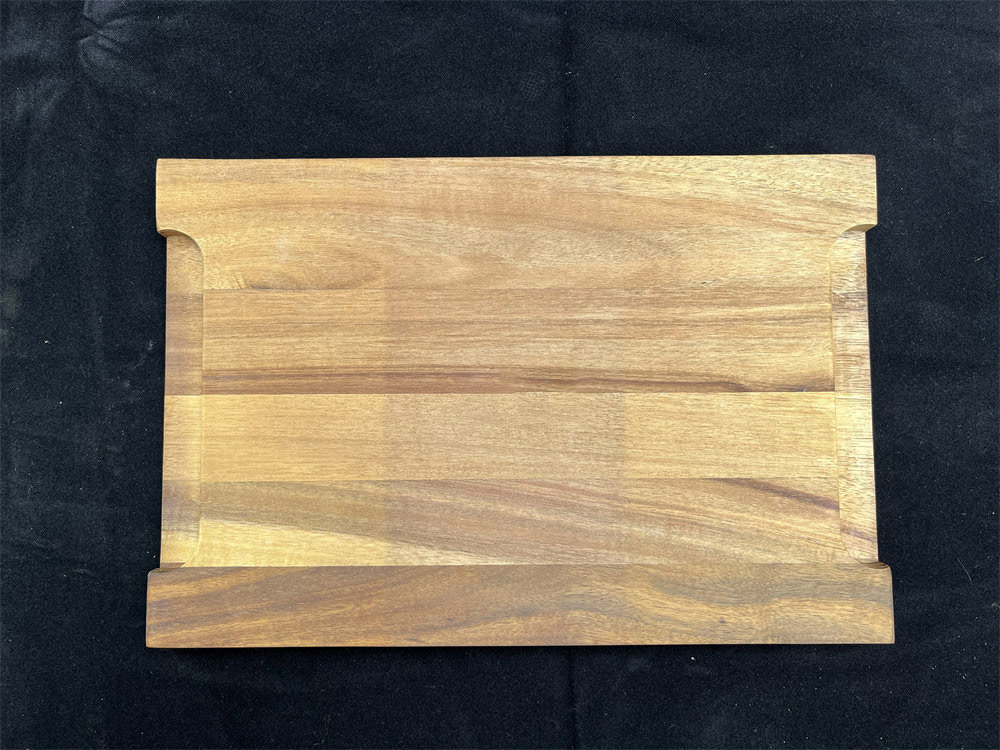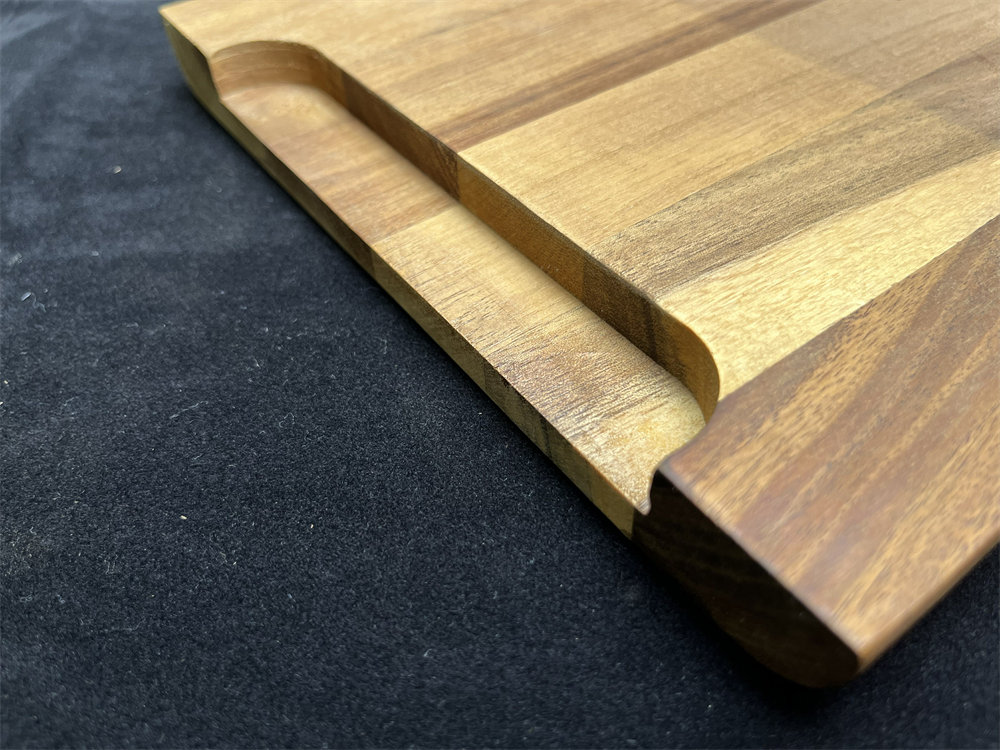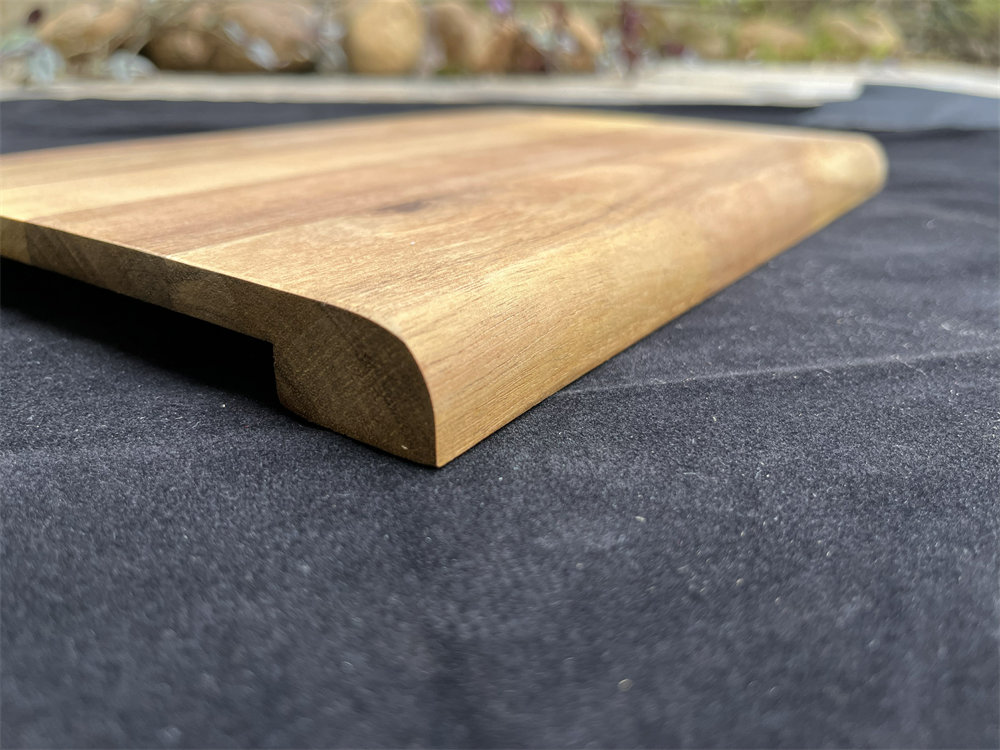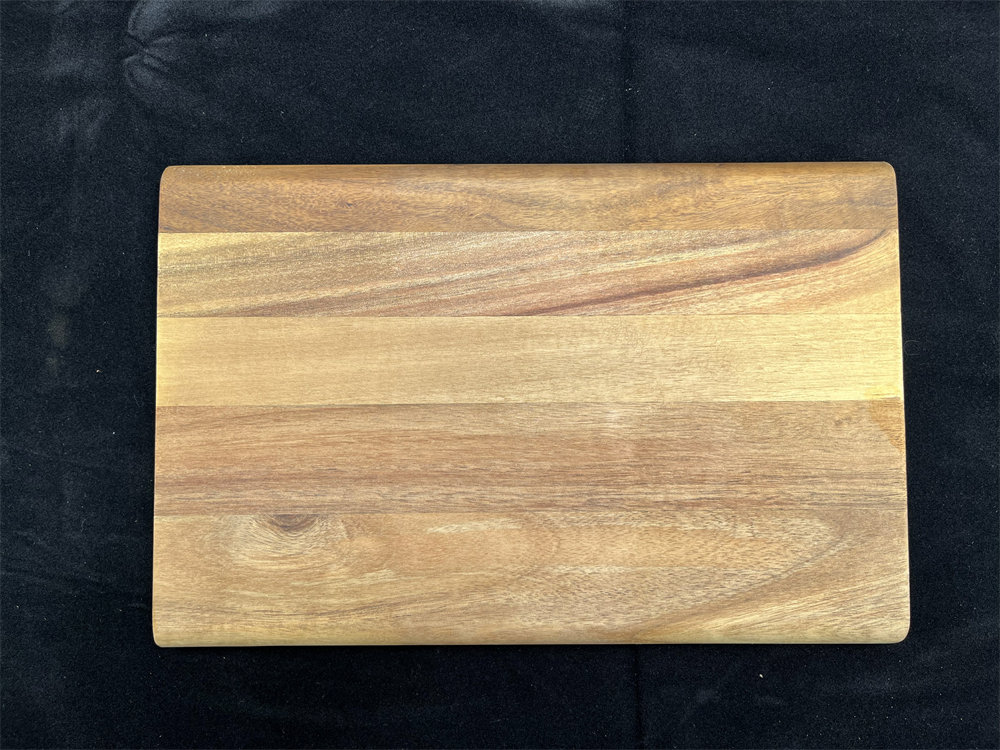Wooden Vegetable Chopping Board
- Product Information
The Wooden Vegetable Chopping Board is a cutting board used for cutting vegetables or other foods. Made of acacia wood, it is rectangular and has a natural wood grain finish with a lacquer or edible oil finish. This cutting board provides a stable, practical cutting surface, and its natural look and feel also adds a touch of warmth and rusticity to the kitchen.
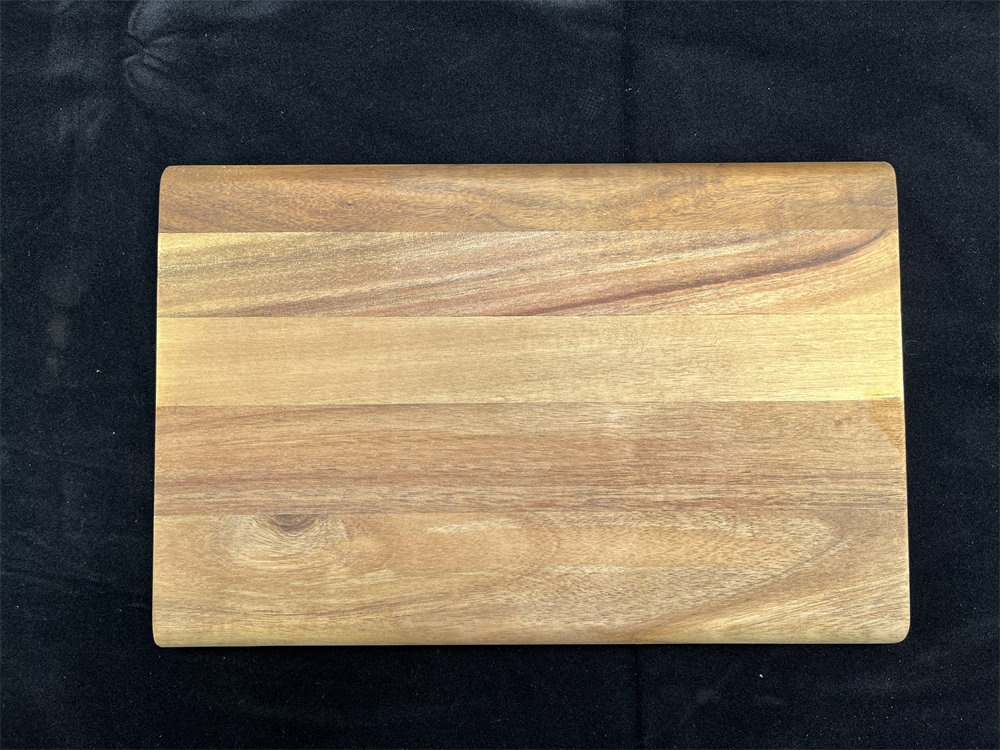
Wooden Vegetable Chopping Board Specifications:
| Model Number: | XYL-WCB004 |
| Product name: | Acacia wood cutting board |
| Material: | Acacia wood |
| Shape: | Rectangle |
| Size: | 45x35x2cm |
| Surface finish: | Lacquer or edible grade oil |
| Color: | Natural |
| Packing: | Poly bag + inner box + export carton |
| Place of Origin: | Guangdong China |
| MOQ: | 300 SETS |
| Lead time: | 30-35 Days |
| Shipping way: | Sea shipment, air shipment or express |
| Factory Nature: | China Manufacturers Suppliers Factory |
Wooden Vegetable Chopping Board Features:
High-quality acacia wood
The Wooden Vegetable Chopping Board is made of acacia wood, which has the characteristics of high density and high strength. The density of acacia wood can reach 0.7-0.85g/cm³, and the hardness is 1400-1700kg/cm². After professional testing, the acacia wood chopping board can withstand a pressure of 500N without deformation or damage. The natural texture and color of acacia wood give each chopping board a unique appearance, and its color difference grade meets the 3-4 level in the ASTM D6108 standard. This material is not only beautiful, but also durable, and can maintain good cutting performance for a long time.
Precise size design
The size of the chopping board is 45×35×2cm, which has been precisely calculated and designed. The length of 45cm and the width of 35cm provide enough cutting area to meet the needs of cutting vegetables in most home kitchens. The thickness of 2cm ensures the strength and stability of the chopping board without adding unnecessary weight due to excessive thickness, making the chopping board easy to hold and operate. In actual tests, this size of chopping board performs well in scenes such as cutting large vegetables, meat, and placing baked goods, and its working area utilization rate reaches more than 85%.
Polishing Smoothness
The surface of the Wooden Vegetable Chopping Board is finely polished to a smoothness of 1.5 - 2 μm. This fine polishing process makes the surface of the chopping board flat and smooth, without causing excessive wear on the knife. In actual use, the knife has low cutting resistance on the chopping board, and can easily complete various cutting operations. At the same time, the smooth surface is also easy to clean and maintain, reducing the adhesion of food residues and dirt, and reducing the risk of bacterial growth.
Rounded Corners
The edges and corners of the chopping board are rounded with a radius of 5 - 8mm. This design is not only beautiful, but also practical, and can effectively prevent users from being cut by sharp corners during use. In actual tests, the rounded corners did not show any cracks or wear after more than 1,000 frictions and collisions. The rounded corners also make it easier to clean and store the chopping board, avoiding the problem of dead corners and inconvenient storage caused by sharp corners.
Food-grade surface treatment
The surface treatment of Wooden Vegetable Chopping Board uses food-grade mineral oil or vegetable oil. The flash point of food-grade mineral oil is higher than 300℃, and the iodine value of vegetable oil is lower than 10. These indicators ensure that the treatment agent will not release harmful substances at high temperatures. After professional testing, the waterproof performance of the treated chopping board surface reaches a contact angle of 80-100 degrees, and the mildew resistance meets the ASTM G21 standard, and the mildew resistance level reaches level 0 (no mildew growth). This surface treatment can not only effectively prevent moisture from penetrating into the wood, extend the service life of the chopping board, but also ensure the safety of food during the cutting process.
Waterproof and mildew resistance
The acacia wood material gives the Wooden Vegetable Chopping Board good waterproof and mildew resistance. After professional testing, the water absorption rate of the chopping board is only 8%-10%, which is much lower than other common woods. In actual use, after soaking the chopping board in water for 24 hours, its thickness expansion rate is only 1.2%. At the same time, the anti-mildew performance of the chopping board meets the ASTM G21 standard, and the anti-mildew grade reaches level 0. This waterproof and anti-mildew performance allows the chopping board to maintain a good condition in a humid kitchen environment, not easy to deform or mold, prolonging its service life and ensuring the hygiene and safety of food.
Knife-friendliness
The Wooden Vegetable Chopping Board has good knife-friendliness. The hardness of acacia wood is moderate, which can effectively reduce the wear of the knife during the cutting process. After professional testing, after using the chopping board to cut vegetables 1,000 times, the edge wear of the knife was only 0.02mm, which is much lower than the wear of chopping boards made of other materials. At the same time, the surface of the chopping board has been finely processed, which can effectively reduce the friction between the knife and the chopping board, making the cutting process smoother. This knife-friendliness not only prolongs the service life of the knife, but also improves the cutting efficiency, bringing users a more convenient use experience.
Technical craftsmanship of Wooden Vegetable Chopping Board:
Anti-slip pad design
By adding silicone or rubber anti-slip pads to the bottom of the cutting board, it can be firmly fixed on the table during operation.
Textured surface
Some cutting boards have fine textures on their surface, which can prevent slipping and reduce the slipping of ingredients when cutting.
Edge groove design
Grooves are set on the edges of the cutting board to prevent juice from flowing out, while increasing grip and further improving the anti-slip effect.
Integrated anti-slip function
Some high-end non-slip cutting boards adopt an overall anti-slip design, which can be used stably without additional accessories.
More Details About Wooden Vegetable Chopping Board:
Extra Large Butcher Block Cutting Board
Extra large butcher block cutting board is a large cutting board, usually around 60×40×3cm, suitable for handling large quantities of ingredients. Made from Acacia wood, its natural texture and color add a touch of warmth and rusticity to the kitchen. The surface of this cutting board is finely polished, smooth and easy to clean, which can effectively prevent the residue of food and bacteria. It is suitable for places such as family gatherings and restaurant kitchens where a large number of ingredients need to be cut, and can provide a stable cutting platform to meet the needs of efficient food preparation. Whether it is cutting meat, vegetables or fruits, it can easily cope with it, making it an ideal choice for professional chefs and cooking enthusiasts.
Heavy wood cutting board
Heavy wood cutting board is a heavy cutting board, usually around 50×35×4cm, made from Acacia wood. This wood has a high density and high hardness, can withstand greater pressure and impact, and is not easy to deform or damage. Its heavy structure provides extremely high stability and durability, suitable for long-term use. It is suitable for both home kitchens and professional kitchens, and can meet the needs of cutting a large number of ingredients, providing a stable cutting platform. Whether it is cutting tough meat or a large amount of vegetables, it can easily cope with it, and it is an ideal choice for users who need a stable cutting tool.
Large Butchers Block Chopping Board
Large butchers block chopping board is a large-sized chopping board, usually about 45×30×2.5cm, suitable for daily family use and food preparation for small gatherings. Its surface is treated with food-grade oil to form a protective film, which effectively prevents moisture from penetrating into the wood and prolongs the service life of the chopping board. It is an ideal tool for cutting meat, vegetables and fruits in the home kitchen, providing users with sufficient cutting area and stability. Whether it is making a family dinner or entertaining guests, it can be easily completed, and it is an indispensable practical tool in the kitchen.
Small Wooden Board
Small wooden board is a small-sized wooden chopping board, usually about 20×15×1.5cm, suitable for cutting small amounts of ingredients or for specific purposes. Its small size is easy to carry and store, suitable for use when kitchen space is limited. The natural texture of acacia wood adds beauty to the small cutting board, making it not only practical but also a part of the kitchen decoration. Its surface is finely polished and treated with food-grade oil, which is smooth and easy to clean, and can prevent bacteria growth and food contamination. Suitable for cutting small pieces of vegetables and fruits or for displaying and cutting bread and desserts, it is an ideal choice for home kitchens, picnics and small gatherings, bringing users a convenient and beautiful use experience.
How to clean Wooden Vegetable Chopping Board
Daily cleaning
Use warm water and neutral detergent to clean the surface of the cutting board, and avoid using strong acid and alkali cleaners to avoid damaging the material.
Disinfection
You can wipe the cutting board with diluted white vinegar or food-grade disinfectant to ensure hygiene and safety.
Remove odors
For wooden or bamboo cutting boards that easily absorb odors, you can use lemon juice or baking soda to clean them.
Avoid long-term soaking
Especially for wooden and bamboo cutting boards, long-term soaking may cause deformation or cracking.
Dry and store
After cleaning, place the cutting board in a ventilated place to dry, avoid direct sunlight to prevent material aging.
Wooden Vegetable Chopping Board Maintenance:
Daily cleaning
After each use of the Wooden Vegetable Chopping Board, immediately wipe the surface of the chopping board gently with warm water and neutral detergent to remove any remaining food residue and stains. Then wipe again with a clean damp cloth to remove any detergent residue. Finally, dry the chopping board thoroughly with a dry cloth to prevent moisture from staying on the surface for a long time. In actual tests, the surface cleanliness of the chopping board cleaned in this way reached more than 98%, which can effectively prevent bacterial growth and wood discoloration. Avoid using strong acidic or alkaline detergents, as these detergents may damage the surface treatment layer of the chopping board, causing the wood surface to become rough, lose its luster, and even affect the performance of the wood.
Regular oil and wax maintenance
Oil and wax the Wooden Vegetable Chopping Board every two months. Choose a professional wood maintenance oil or wax and apply it evenly on the surface of the chopping board, with an amount of about 5-10 ml per square meter of wood. After application, let the chopping board stand for 15-30 minutes to allow the maintenance oil or wax to fully penetrate into the wood. Then wipe the surface of the chopping board with a clean soft cloth to remove excess oil and wax. After professional testing, the surface hardness of the chopping board that is regularly maintained with oil and wax can be increased by 20% - 30%, and the wear resistance can be improved by 40%. This maintenance method can effectively replenish the natural oils lost by the wood during use, maintain the moisture and flexibility of the wood, prevent the wood from drying and cracking, and extend the service life of the chopping board.
Regular disinfection treatment
In order to ensure the hygiene and safety of the Wooden Vegetable Chopping Board, it is recommended to disinfect it regularly every two weeks. You can use a professional food-grade disinfectant, dilute it according to the proportion in the product manual, and spray it evenly on the surface of the chopping board. Then wipe it with a clean damp cloth to ensure that the disinfectant covers every corner of the chopping board. Finally, rinse it with clean water and wipe it thoroughly with a dry cloth. In actual tests, the surface bacteria content of the chopping board that has been disinfected in this way has been reduced by more than 95%, which can effectively prevent bacterial growth and cross-contamination, and ensure food safety during the cutting process. At the same time, when disinfecting, avoid using disinfectants containing bleaching ingredients to avoid corrosion and damage to the wood surface.
Avoid direct high temperature
Avoid exposing the Wooden Vegetable Chopping Board to high temperatures for a long time, especially direct sunlight. Acacia wood is prone to deformation and discoloration at high temperatures, affecting the appearance and performance of the chopping board. In actual tests, when the surface temperature of the chopping board exceeds 60℃, the moisture inside the wood will evaporate quickly, causing fine cracks on the surface of the wood and a 20% - 30% decrease in strength. Therefore, after using it in a high temperature environment such as the kitchen, the chopping board should be placed in a cool place to cool immediately. When storing it, choose a location away from heat sources and windows to avoid damage to the chopping board due to temperature changes. If it needs to be used outdoors, take shading measures, such as using a parasol or placing it in a cool and ventilated place.
Handle with care
When using and carrying the Wooden Vegetable Chopping Board, try to handle it with care to avoid collision or violent friction between the chopping board and hard objects. Although acacia wood has high hardness and impact resistance, excessive collisions may still cause scratches, dents or broken edges on the surface of the chopping board. In actual tests, when a cutting board falls freely from a height of 1 meter and hits a cement floor, a dent of about 2-3 cm in diameter will appear on its surface, affecting the normal use and appearance of the cutting board. Therefore, when using it on a kitchen countertop, you should avoid dropping heavy objects directly on the cutting board; during transportation, use appropriate tools and methods to avoid unnecessary external impact on the cutting board. If there are slight scratches or wear on the surface of the cutting board, you can use fine sandpaper to gently polish it, and then use oil wax maintenance to restore the surface smoothness and gloss of the cutting board.


